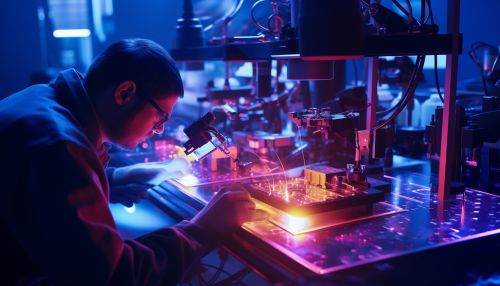Biophotonics
Overview
Biophotonics is a multidisciplinary research field that uses light-based technologies to study biological materials. This field combines aspects of biology, physics, chemistry, and engineering to create tools and techniques for understanding the mechanisms of life at the molecular level. Biophotonics has a wide range of applications, including medical diagnostics, therapy, drug discovery, and biological research.
History
The term "biophotonics" was coined in the late 20th century, but the use of light to study biological systems has a much longer history. For example, the microscope, a key tool in biology, was invented in the 17th century. However, the development of lasers in the 1960s and the subsequent advancements in optical technologies have greatly expanded the possibilities of using light in biological research.
Principles
Biophotonics is based on the interaction of light with biological materials. This interaction can be described by the principles of optics and quantum mechanics. When light interacts with a biological material, it can be absorbed, reflected, refracted, or scattered. These interactions can provide information about the material's structure and composition.


Techniques
There are many techniques in biophotonics, including:
Microscopy
Optical microscopy is a fundamental technique in biophotonics. It uses light to magnify and visualize biological samples. There are many types of optical microscopes, including fluorescence microscopes, confocal microscopes, and two-photon excitation microscopes.
Spectroscopy
Spectroscopy is a technique that uses the interaction of light with matter to determine the properties of a sample. In biophotonics, spectroscopy can be used to study the chemical composition and structure of biological materials.
Imaging
Imaging techniques in biophotonics use light to create images of biological materials. These techniques include optical coherence tomography, photoacoustic imaging, and fluorescence lifetime imaging.
Applications
Biophotonics has a wide range of applications, including:
Medicine
In medicine, biophotonics can be used for diagnostics and therapy. For example, optical coherence tomography can be used to image the retina and diagnose eye diseases. Photodynamic therapy, which uses light to activate a drug, is a form of cancer treatment.
Biology
In biology, biophotonics can be used to study the structure and function of biological systems. For example, fluorescence microscopy can be used to visualize cellular structures and processes.
Drug Discovery
In drug discovery, biophotonics can be used to screen potential drugs and study their effects on cells and tissues.
Future Directions
The field of biophotonics is rapidly evolving, with new technologies and applications being developed. Future directions may include the development of more advanced imaging techniques, the integration of biophotonics with other technologies such as nanotechnology and genomics, and the application of biophotonics in personalized medicine.
